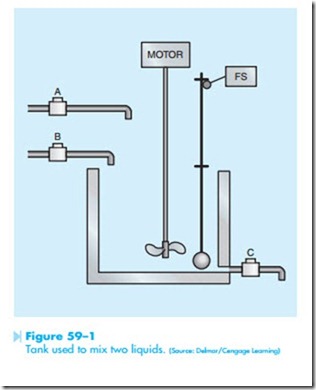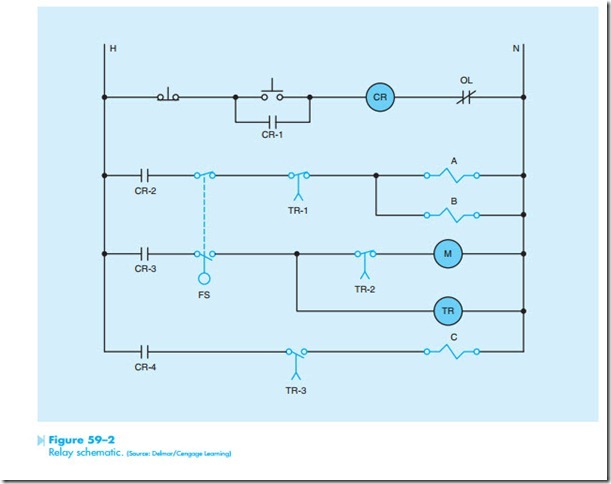In this unit a relay schematic will be converted into a diagram used to program a programmable logic controller. The process to be controlled is shown in Figure 59–1. A tank is used to mix two liquids. The control circuit operates as follows:
1. When the start button is pressed, solenoids
A and B energize. This permits the two liquids to begin filling the tank.
2. When the tank is filled, the float switch trips.
This deenergizes solenoids A and B and starts the motor used to mix the liquids together.
3. The motor is permitted to run for one minute. After one minute has elapsed, the motor turns off and solenoid C energizes to drain the tank.
4. When the tank is empty, the float switch deenergizes solenoid C.
5. A stop button can be used to stop the process at any point.
6. If the motor becomes overloaded, the action of the entire circuit will stop.
7. Once the circuit has been energized it will continue to operate until it is manually stopped.
CIRCUIT OPERATION
A relay schematic that will perform the logic of this circuit is shown in Figure 59–2. The logic of this circuit is as follows:
1. When the start button is pushed, relay coil CR is energized. This causes all CR contacts to close. Contact CR-1 is a holding contact used to maintain the circuit to coil CR when the start button is released.
2. When contact CR-2 closes, a circuit is completed to solenoid coils A and B. This permits the two liquids that are to be mixed together to begin filling the tank.
4. When the normally closed float switch opens, solenoid coils A and B deenergize and stop the flow of the two liquids into the tank.
5. When the normally open contact closes, a circuit is completed to the coil of a motor starter and the coil of an on-delay timer. The motor is used to mix the two liquids together.
6. At the end of the one minute time period, all of the TR contacts change position. The normally closed TR-2 contact connected in series with the motor starter coil opens and stops the operation of the motor. The energizes solenoid coil C which permits liquid to begin draining from the tank. The normally closed TR-1 contact is used to assure that valves A and B cannot be reenergized until solenoid C deenergizes.
7. As liquid drains from the tank, the float drops. When the float drops far enough, the float switch trips and its contacts return to their normal positions. When the normally open float switch contact reopens and de-energizes coil TR, all TR contacts return to their normal positions.
8. When the normally open TR-3 contact reopens, solenoid C deenergizes and closes the drain valve. Contact TR-2 recloses, but the motor cannot restart because of the normally open float switch contact. When contact TR-1 recloses, a circuit is completed to sole- noids A and B. This permits the tank to begin refilling, and the process starts over again.
9. If the stop button or overload contact opens, coil CR deenergizes and all CR contacts open. This deenergizes the entire circuit.

